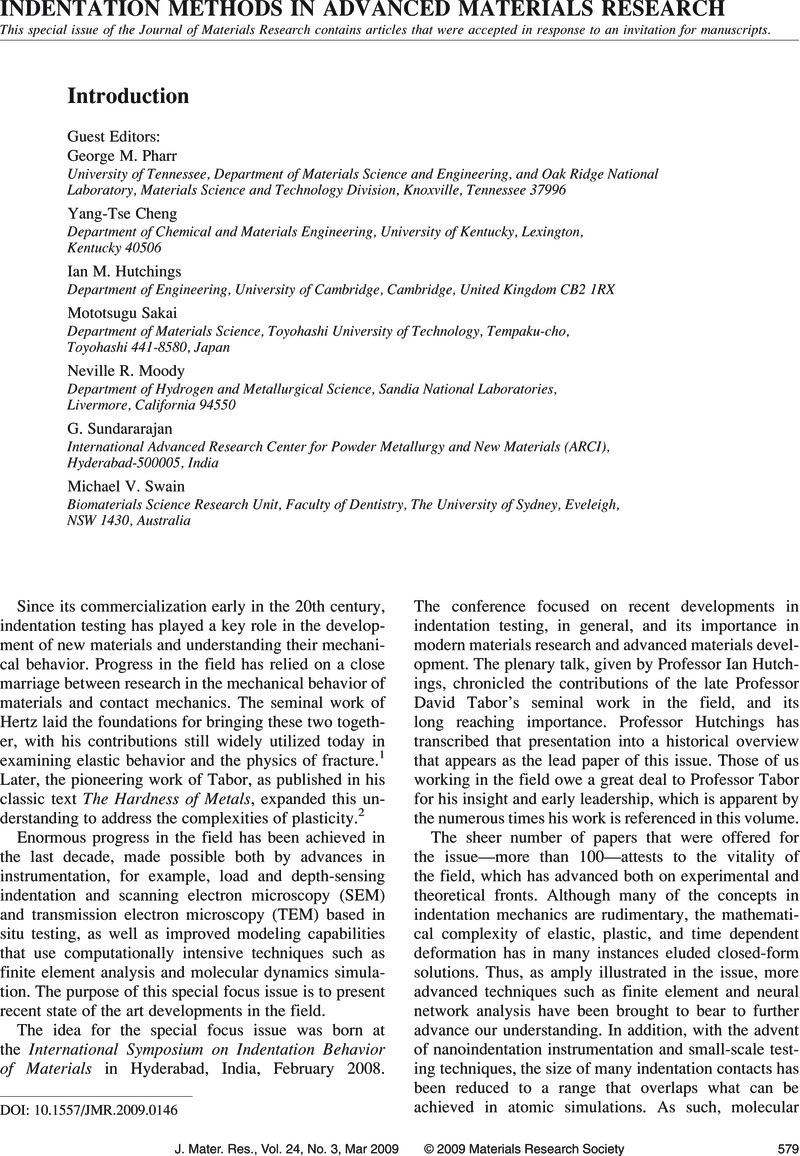Crossref Citations
This article has been cited by the following publications. This list is generated based on data provided by Crossref.
Hay, J.
2009.
INTRODUCTION TO INSTRUMENTED INDENTATION TESTING.
Experimental Techniques,
Vol. 33,
Issue. 6,
p.
66.
Cheng, Yang-Tse
and
Yang, Fuqian
2009.
Obtaining shear relaxation modulus and creep compliance of linear viscoelastic materials from instrumented indentation using axisymmetric indenters of power-law profiles.
Journal of Materials Research,
Vol. 24,
Issue. 10,
p.
3013.
Lucca, D.A.
Herrmann, K.
and
Klopfstein, M.J.
2010.
Nanoindentation: Measuring methods and applications.
CIRP Annals,
Vol. 59,
Issue. 2,
p.
803.
Yang, Rong
Zhang, Taihua
and
Feng, Yihui
2010.
Theoretical analysis of the relationships between hardness, elastic modulus, and the work of indentation for work-hardening materials.
Journal of Materials Research,
Vol. 25,
Issue. 11,
p.
2072.
Liu, D.X.
Zhang, Z.D.
and
Sun, L.Z.
2010.
Nonlinear elastic load–displacement relation for spherical indentation on rubberlike materials.
Journal of Materials Research,
Vol. 25,
Issue. 11,
p.
2197.
Cheng, Yang-Tse
2011.
Time Dependent Constitutive Behavior and Fracture/Failure Processes, Volume 3.
p.
119.
Guo, Jun Hong
Ma, De Jun
Chen, Wei
and
Song, Zhong Kang
2012.
Analysis on Mechanical Properties of Instrumented Indentation Tester Frame.
Applied Mechanics and Materials,
Vol. 215-216,
Issue. ,
p.
895.
Ma, De Jun
Guo, Jun Hong
Chen, Wei
and
Song, Zhong Kang
2012.
Investigation of Relationship between Instrumented Indentation Nominal Hardness and Reduced Elastic Modulus with Large Apex Angle Indenter.
Applied Mechanics and Materials,
Vol. 198-199,
Issue. ,
p.
193.
Wang, Jia Liang
Ma, De Jun
Chen, Wei
Huang, Yong
and
Sun, Liang
2014.
Analysis of Pop-In Phenomenon in the Process of Ceramic Materials Instrumented Indentation.
Advanced Materials Research,
Vol. 941-944,
Issue. ,
p.
564.
de Cagny, H.
Rouwhorst, J.C.
Arnaudov, L.
Stoyanov, S.
Blijdenstein, T.B.J.
and
Schall, P.
2021.
Water migration through fat-based semi solid heterogeneous materials.
Food Structure,
Vol. 29,
Issue. ,
p.
100208.
Deillon, L.
Fornabaio, M.
Zagar, G.
Michelet, L.
and
Mortensen, A.
2021.
Processing and micro-mechanical characterization of multi-component transition MC carbides in iron.
Journal of the European Ceramic Society,
Vol. 41,
Issue. 7,
p.
3937.





